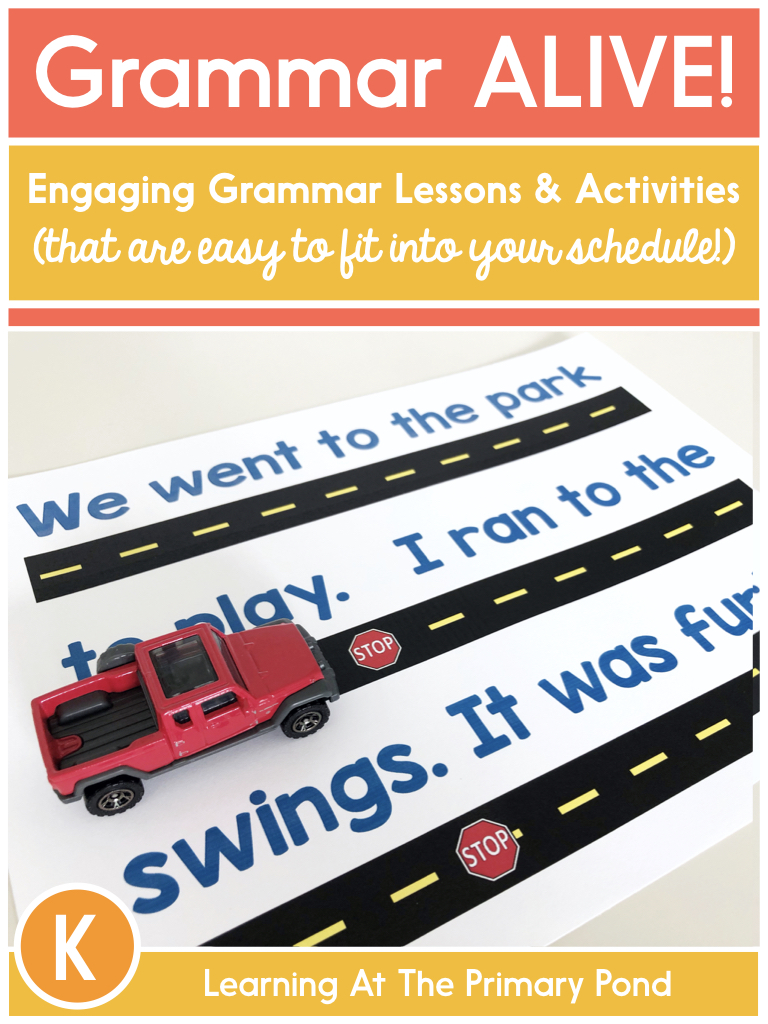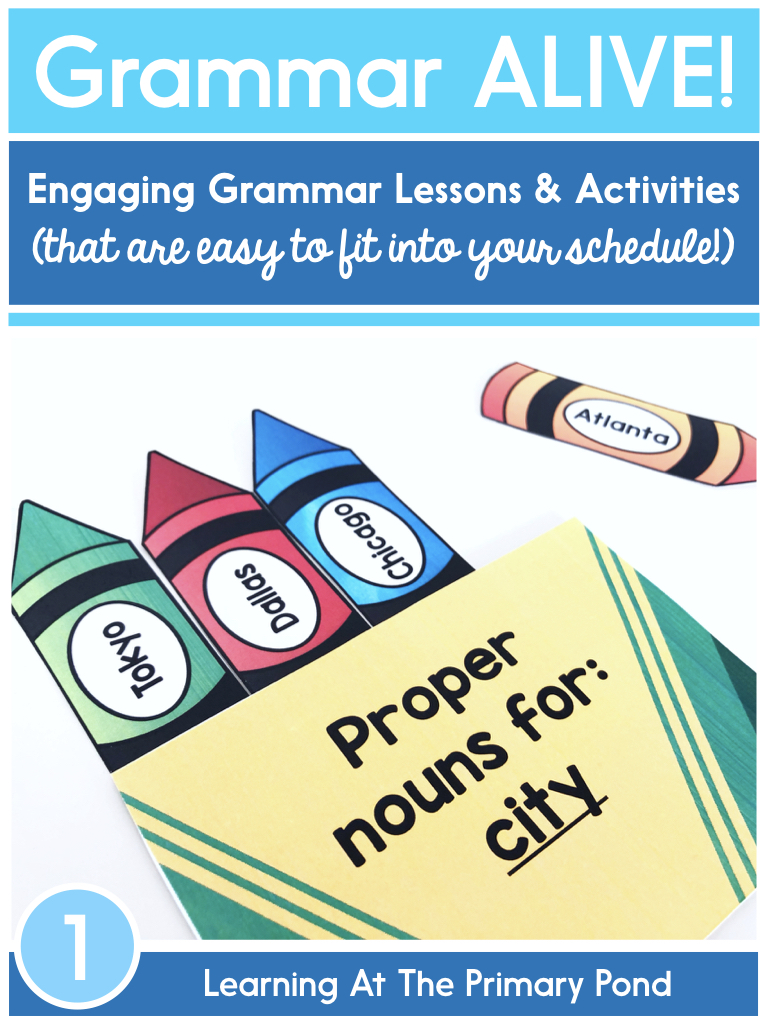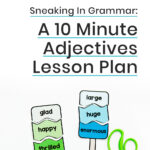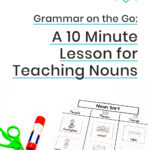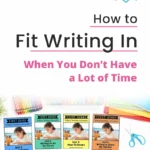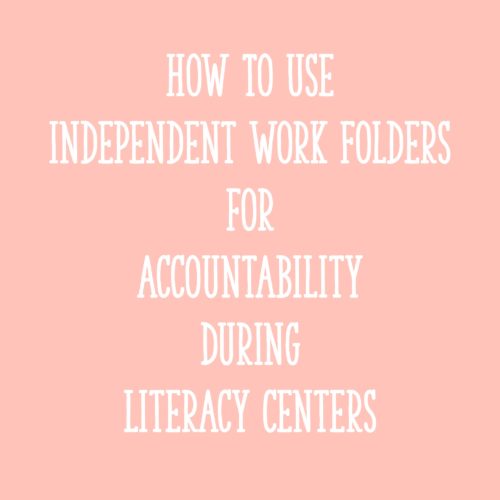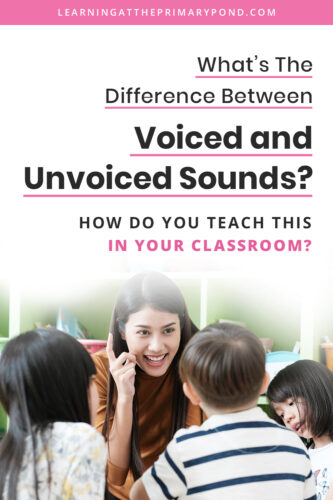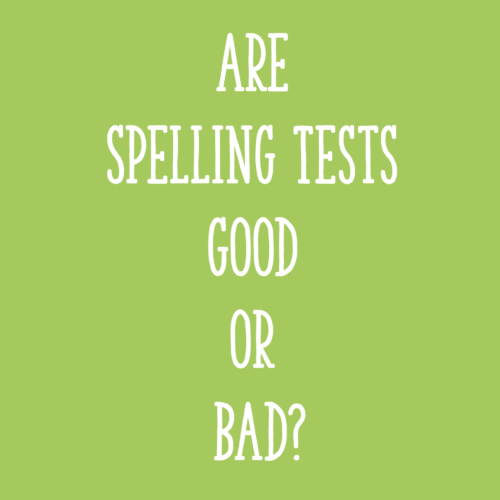Do you want to make your grammar instruction more fun and engaging for your K-2 students?
Are you desperate to figure out how to get your kids to actually REMEMBER and APPLY the grammar and conventions rules you teach?
Teaching grammar is difficult, I know!! Coming out of my undergraduate teacher prep program, I really had no idea how to teach it.
I mean, I knew what grammar drills were…but I wasn’t sure how to get kids to apply their learning to their writing. I wasn’t sure which skills were appropriate to teach at each grade level. And I wasn’t sure how to make grammar relevant to my reading and writing instruction.
Not gonna lie…in some years, my grammar and conventions instruction just did not cut it. (Sorry, kids!! ??)
I was determined to fix that, though. I’ve done a lot of learning about effective grammar instruction and how to directly integrate it into my writing instruction.
Plus, I’ve learned how to keep lessons fun and appropriate for our youngest students!
And now, I’m SO excited to share what I’ve learned with you — in my “Grammar ALIVE!” 3-part approach!
This approach will help you teach your students grammar rules and conventions (punctuation, capitalization, parts of speech, etc.). It’ll keep your kids engaged and follow best practices in grammar instruction!
What are the 3 parts in the approach?
The 3 stages are…
- Explore
- Practice
- Apply
It’s basically the gradual release of responsibility model, but it looks a little different from other literacy skills. Keep reading to learn more about each stage!
Where did this 3-part process come from?
As I explained above, it was hard for me to figure out how to make grammar instruction engaging and effective. For many of us teachers, the grammar activities we did growing up do NOT match best practices in grammar instruction.
I wanted to make sure that my grammar instruction was fun, relevant, primary-friendly, and grounded in best practices—and I couldn’t find a resource that accomplished all of this. So, since about 2011, I’ve been working on my “Grammar Alive!” approach and activities!
Is this really relevant for Kindergarten?
Yes! I use these three basic stages with my Kinders, but the activities look a little different than they do in 1st and 2nd grade. I like to make sure that my grammar activities are embedded in Kinder-appropriate, fun literacy activities that I already include in our everyday activities. At the end of the post, I’ve included a Kindergarten example so you can see exactly what I mean!
Okay, let’s dive in!
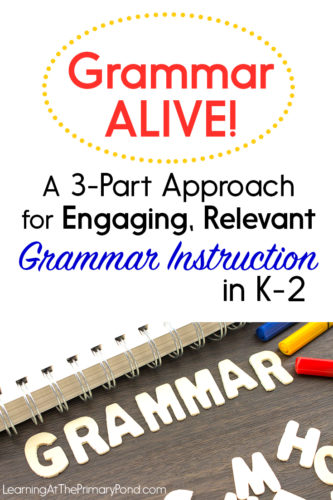
Stage 1: Explore
In this stage, students are—literally—getting to know the convention or grammar rule.
During this stage, we want to show students examples of the convention used correctly. We want to show them how authors use the convention in real texts.
Possible activities for this stage (you may or may not use all of these activities for every skill you teach, but I always recommend doing at least the first two):
- Show students examples of sentences with the convention, including some examples from texts students are already familiar with
- Discuss WHY writers use the convention, what effect it has on the reader, and how it can change the meaning of text
- Compare and contrast sentences that use the convention, discussing how they are alike and different
- Read aloud a picture book about the convention
- Do a “Highlight What’s Right” activity where students identify examples of the convention used correctly
- Engage students in hands-on practice activities or activities involving physical movement
How long does this stage last?
It really depends. If it’s a writing convention or grammar rule that students already learned in previous years, maybe this stage only lasts 1 day. Or maybe it’s something super challenging and it lasts a week and a half or more! In my experience, most skills fall somewhere in the 1-3 day range.
Stage 2: Practice
In this stage, students have seen enough examples of the convention and are ready to try it out, in an isolated setting, with support.
Possible activities for this stage (you may or may not use all of them, but I recommend at least doing the first four):
- Model how to write a sentence that uses the convention (may need to model more than once)
- Have students ORALLY come up with a similar sentence and discuss how they plan to use the convention in it (if applicable; going straight to writing may be best in some cases)
- Have students work independently or with a partner to write a sentence that uses the convention (students may be imitating teacher’s sentence to some degree)
- Discuss how texts would be different if the convention were not used, or if it were used differently
- Play a game or engage in some activity that involves more practice
How long does this stage last?
Again, it varies, depending on your class and what skill you’re working on. I usually allow for 2-4 practice opportunities.
Stage 3: Apply
It’s tempting to rush this stage, but don’t! Students really need to be familiar with the convention and have had supportive practice opportunities before we ask them to apply the skill to their own writing.
In this stage, students begin by adding sentence(s) to their own writing that go along with the skill. Later, they’re asked to edit some of their writing, applying their knowledge of the skill.
Possible activities for this stage:
- Model how you add a sentence with the target convention to a sample piece of writing you’ve been working on
- Students make suggestions for adding sentences to a class piece of writing or a sample created by you
- Students work independently or with partners to add sentences to their own writing (with your guidance)
- Students help you edit a class piece of writing or a sample created by you, using the target convention/rule
- Students work with partners to edit their own writing for the target convention/rule
- As a class, you add the convention to students’ editing checklist (note that this comes last!)
How long does this stage last?
‘Till kids can actually apply something to their writing? Approximately…forever! ?
Just kidding.
But in all seriousness, even though you may set aside 1-2 days for the main activities, you’ll likely be working with students on the target skill for the rest of the school year. All of this takes time, and plenty of it!
The Research
To read more about the best practices that this 3-part approach is based on (and see a list of reference texts with great information), please check out this post.
Update! The grammar series is now complete! You can read each post in the series here:
- Best Practices for Teaching Grammar in K-2
- How to Integrate Grammar Into Your Writing Instruction
- How to Integrate Grammar Instruction Into Shared Reading or Close Reading
- How to Find Time for Grammar Instruction
- 5 Tips for Helping K-2 Students Actually Apply Their Grammar Learning
- Grammar Skills by Grade Level: a List of Grammar, Language, and Writing Conventions to Teach in K-2
- 15 Picture Books For Teaching Grammar and Conventions
Examples (Freebies!)
I thought it would be helpful to share some Kindergarten, first grade, and second grade examples with you so that you can see what these stages look like on a concrete level (especially with Kinder, as it’s a bit different).
Each free week of plans is designed to be taught mid-way through the school year. This means that the lessons before it are easier (especially for Kinder), and some of the lessons after it may be a bit harder. I’ve included a scope and sequence in each file, too.
Click below to download an example of each!
Get the complete program!
If you want to make grammar come ALIVE for your students (and stop spending time worrying about it and planning for it!), grab my Kindergarten, 1st grade, or 2nd grade “Grammar Alive!” program. Click any image below to read more about it!
Happy teaching!

